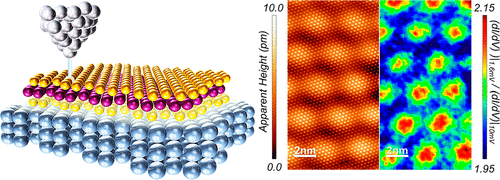Our official English website, www.x-mol.net, welcomes your
feedback! (Note: you will need to create a separate account there.)
Proximity-Induced Superconductivity in Monolayer MoS2.
ACS Nano ( IF 15.8 ) Pub Date : 2020-01-13 , DOI: 10.1021/acsnano.9b07475 Daniel J Trainer 1 , BaoKai Wang 2 , Fabrizio Bobba 1, 3 , Noah Samuelson 4 , Xiaoxing Xi 1 , John Zasadzinski 4 , Jouko Nieminen 2, 5 , Arun Bansil 2 , Maria Iavarone 1
ACS Nano ( IF 15.8 ) Pub Date : 2020-01-13 , DOI: 10.1021/acsnano.9b07475 Daniel J Trainer 1 , BaoKai Wang 2 , Fabrizio Bobba 1, 3 , Noah Samuelson 4 , Xiaoxing Xi 1 , John Zasadzinski 4 , Jouko Nieminen 2, 5 , Arun Bansil 2 , Maria Iavarone 1
Affiliation

|
Proximity effects in superconducting normal (SN) material heterostructures with metals and semiconductors have long been observed and theoretically described in terms of Cooper pair wave functions and Andreev reflections. Whereas the semiconducting N-layer materials in the proximity experiments to date have been doped and tens of nanometers thick, we present here a proximity tunneling study involving a pristine single-layer transition-metal dichalcogenide film of MoS2 placed on top of a Pb thin film. Scanning tunneling microscopy and spectroscopy experiments together with parallel theoretical analysis based on electronic structure calculations and Green's function modeling allow us to unveil a two-step process in which MoS2 first becomes metallic and then is induced into becoming a conventional s-wave Bardeen-Cooper-Schrieffer-type superconductor. The lattice mismatch between the MoS2 overlayer and the Pb substrate is found to give rise to a topographic moiré pattern. Even though the induced gap appears uniform in location, the coherence peak height of the tunneling spectra is modulated spatially into a moiré pattern that is similar to but shifted with respect to the moiré pattern observed in topography. The aforementioned modulation is shown to originate from the atomic-scale structure of the SN interface and the nature of local atomic orbitals that are involved in generating the local pairing potential. Our study indicates that the local modulation of induced superconductivity in MoS2 could be controlled via geometrical tuning, and it thus shows promise toward the integration of monolayer superconductors into next-generation functional electronic devices by exploiting proximity-effect control of quantum phases.
中文翻译:

单层MoS2中的邻近感应超导。
长期以来,人们一直观察到超导正常(SN)材料与金属和半导体的异质结构中的邻近效应,并根据Cooper对波函数和Andreev反射从理论上对其进行了描述。迄今为止,近程实验中的半导体N层材料已经掺杂并且厚度为数十纳米,我们在此提出了一种近程隧穿研究,其中涉及将MoS2的原始单层过渡金属二卤化二硫化钨薄膜置于铅薄膜顶部。 。扫描隧道显微镜和光谱实验以及基于电子结构计算和Green'的并行理论分析 函数建模使我们能够揭示一个两步过程,其中MoS2首先变成金属,然后被诱导成为常规的s波Bardeen-Cooper-Schrieffer型超导体。发现MoS2覆盖层和Pb衬底之间的晶格失配会产生波纹状莫尔图案。即使引起的间隙在位置上看起来均匀,隧道光谱的相干峰高在空间上也被调制成莫尔条纹,该莫尔条纹类似于但相对于地形图中观察到的莫尔条纹发生了位移。示出的前述调制源自SN接口的原子尺度结构以及在产生局部配对电位中涉及的局部原子轨道的性质。
更新日期:2020-01-13
中文翻译:

单层MoS2中的邻近感应超导。
长期以来,人们一直观察到超导正常(SN)材料与金属和半导体的异质结构中的邻近效应,并根据Cooper对波函数和Andreev反射从理论上对其进行了描述。迄今为止,近程实验中的半导体N层材料已经掺杂并且厚度为数十纳米,我们在此提出了一种近程隧穿研究,其中涉及将MoS2的原始单层过渡金属二卤化二硫化钨薄膜置于铅薄膜顶部。 。扫描隧道显微镜和光谱实验以及基于电子结构计算和Green'的并行理论分析 函数建模使我们能够揭示一个两步过程,其中MoS2首先变成金属,然后被诱导成为常规的s波Bardeen-Cooper-Schrieffer型超导体。发现MoS2覆盖层和Pb衬底之间的晶格失配会产生波纹状莫尔图案。即使引起的间隙在位置上看起来均匀,隧道光谱的相干峰高在空间上也被调制成莫尔条纹,该莫尔条纹类似于但相对于地形图中观察到的莫尔条纹发生了位移。示出的前述调制源自SN接口的原子尺度结构以及在产生局部配对电位中涉及的局部原子轨道的性质。











































 京公网安备 11010802027423号
京公网安备 11010802027423号